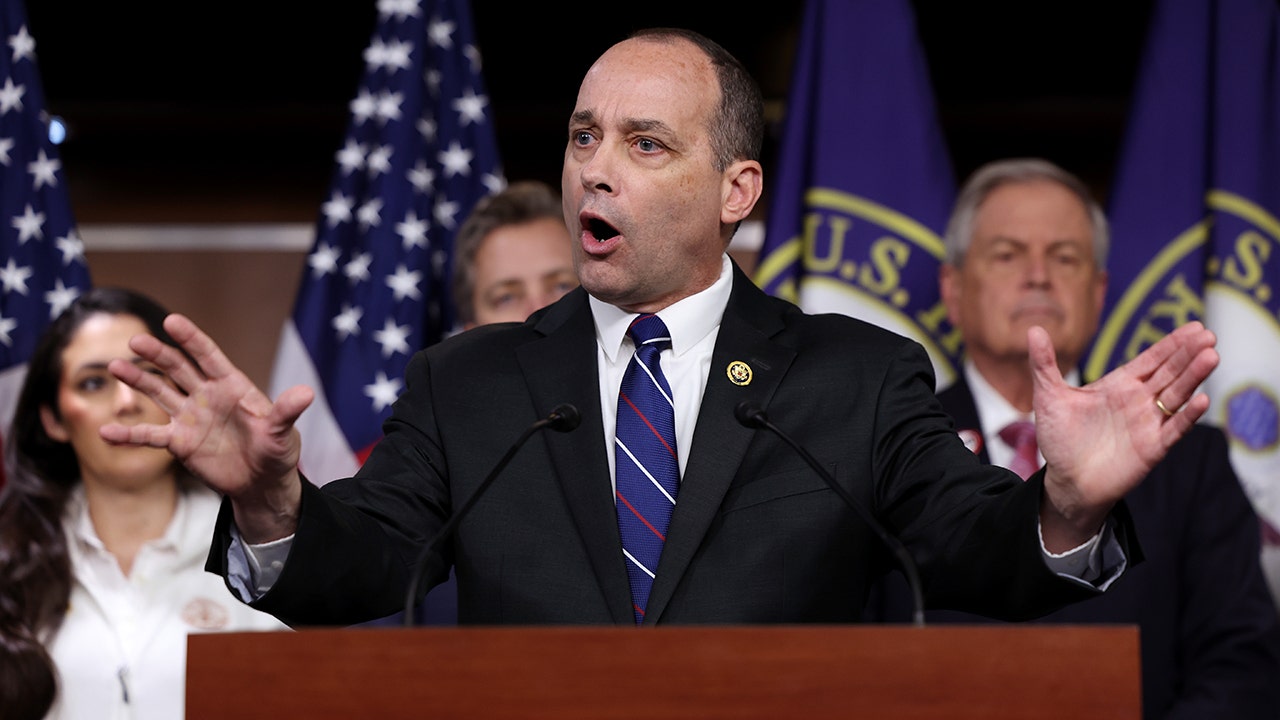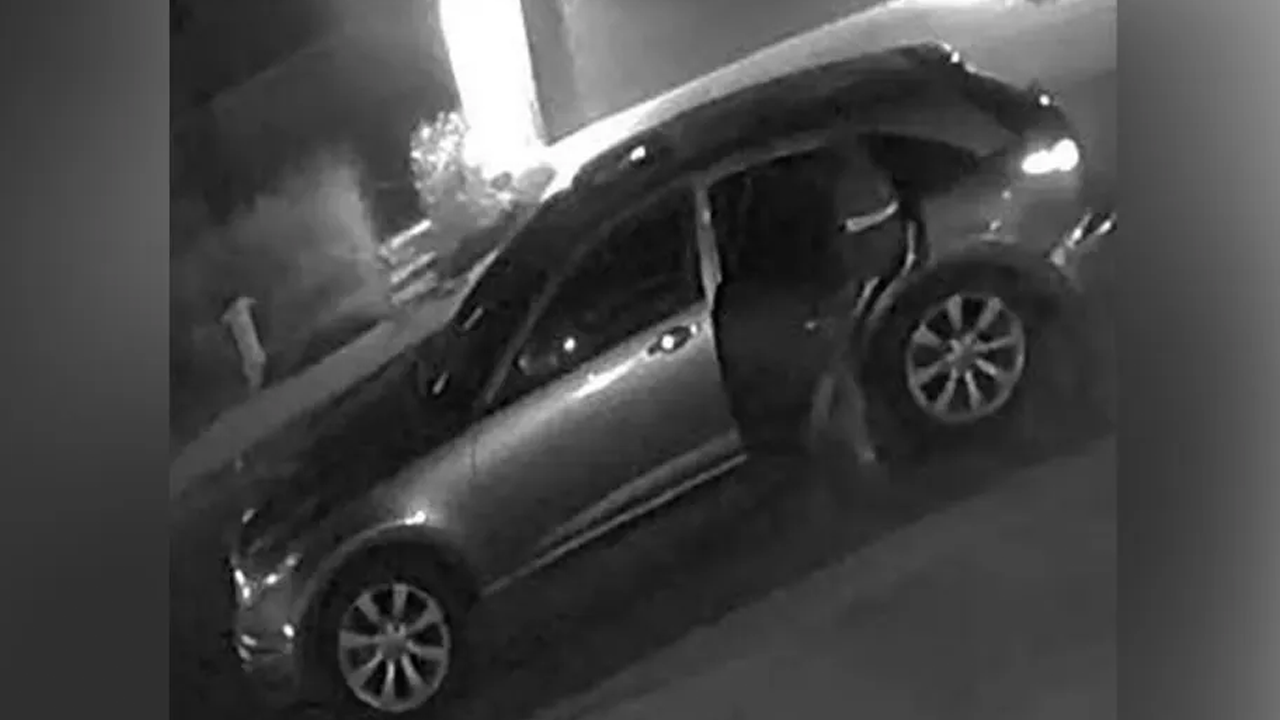Sports
Miguel Rojas, Chris Taylor and Freddie Freeman fuel Dodgers comeback win over Royals
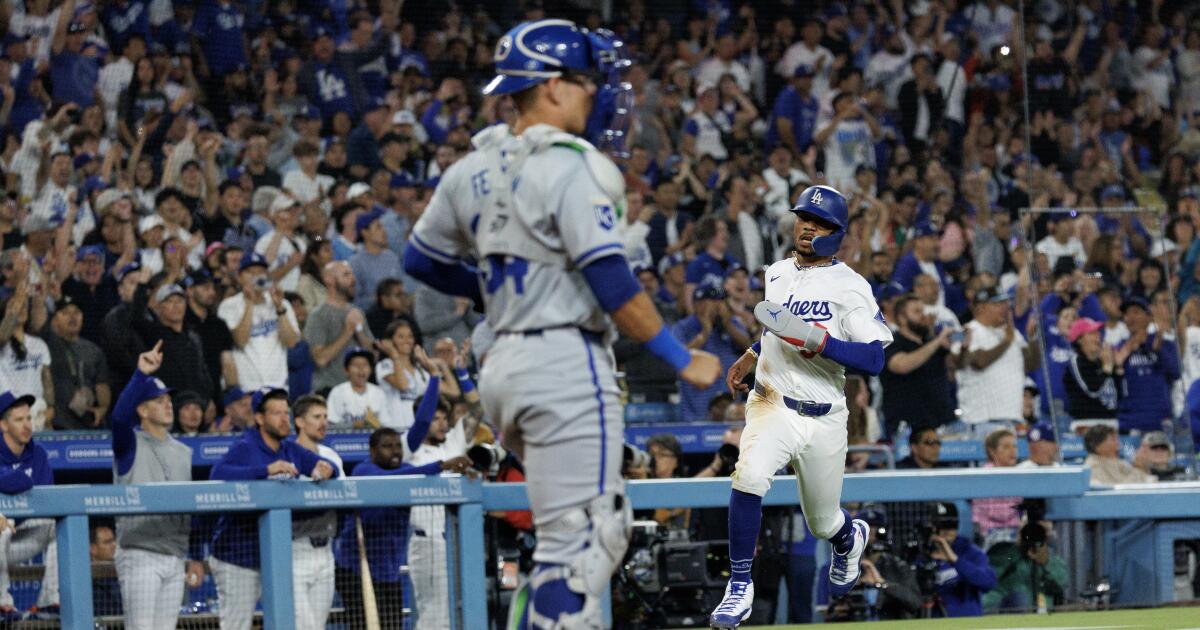
The Dodgers tapped into some unlikely power sources to erase a three-run deficit Friday night, Miguel Rojas and Chris Taylor each hitting home runs in a score-tying fifth inning against the Kansas City Royals in Chavez Ravine.
Then they fired up some fossil fuel to win it, as veteran first baseman Freddie Freeman, who turns 35 in September, poked a two-out, run-scoring single to center field in the eighth inning to lift the Dodgers to a 4-3 victory in front of a crowd of 49,580.
Mookie Betts sparked the winning rally off Royals left-hander Will Smith with a one-out single to left field, and he took second on Smith’s errant pick-off throw to first.
Shohei Ohtani popped out to shortstop, but Freeman reached out for an 83-mph slider off the plate and lofted a single to center off his former Atlanta Braves teammate — the ball left his bat at 75.7 mph — to score Betts for a 4-3 lead.
Freeman felt like he underachieved for two months, with a .286 average and .842 on-base-plus-slugging percentage through the end of May, but he has lived up to his lofty standards in June, batting .357 (15 for 42) with three homers, three doubles and nine RBIs in 12 games to lift his season average to .297 and OPS to .892.
“Freddie knows how to get a hit,” Dodgers manager Dave Roberts said. “Coming through in that spot, I know it was a big weight off his shoulders.”
Taylor, the seldom-used utility man who entered Friday with a .100 average, .307 OPS and 41 strikeouts in 103 plate appearances, can relate. With his first homer of the season, he felt like a few cinder blocks were removed from his shoulders.
Freddie Freeman drives in the go-ahead run on a single in the eighth inning against the Royals on Friday.
(Gina Ferazzi / Los Angeles Times)
“Yeah, it’s been a while,” said Taylor, who hadn’t homered since last Sept. 7, a span of 165 plate appearances. “I think it was more of a relief than anything. I wasn’t sure I was ever going to get to do that again.”
Royals starter Cole Ragans, whose five-pitch mix featured a fastball that averaged 96.2 mph and topped out at 98.3 mph, was nearly untouchable for four innings, giving up one single and striking out two, and Salvador Perez staked the left-hander to a 3-0 lead with a three-run homer in the top of the fourth.
But that lead disappeared in the span of four bottom-of-the-order batters in the fifth, a rally that rookie Andy Pages sparked with a one-out infield single.
Rojas got ahead with a 3-and-1 count and turned on a 94-mph fastball from Ragans, driving his third homer of the season — and 47th of his 11-year career — 390 feet to left field to pull the Dodgers to within 3-2.
“That was a big hit for us, kind of gave us some life,” Roberts said. “Ragans was throwing the ball so well that one moment, you’re thinking you might get no-hit, and the next thing you know, you’re back in the ballgame.”
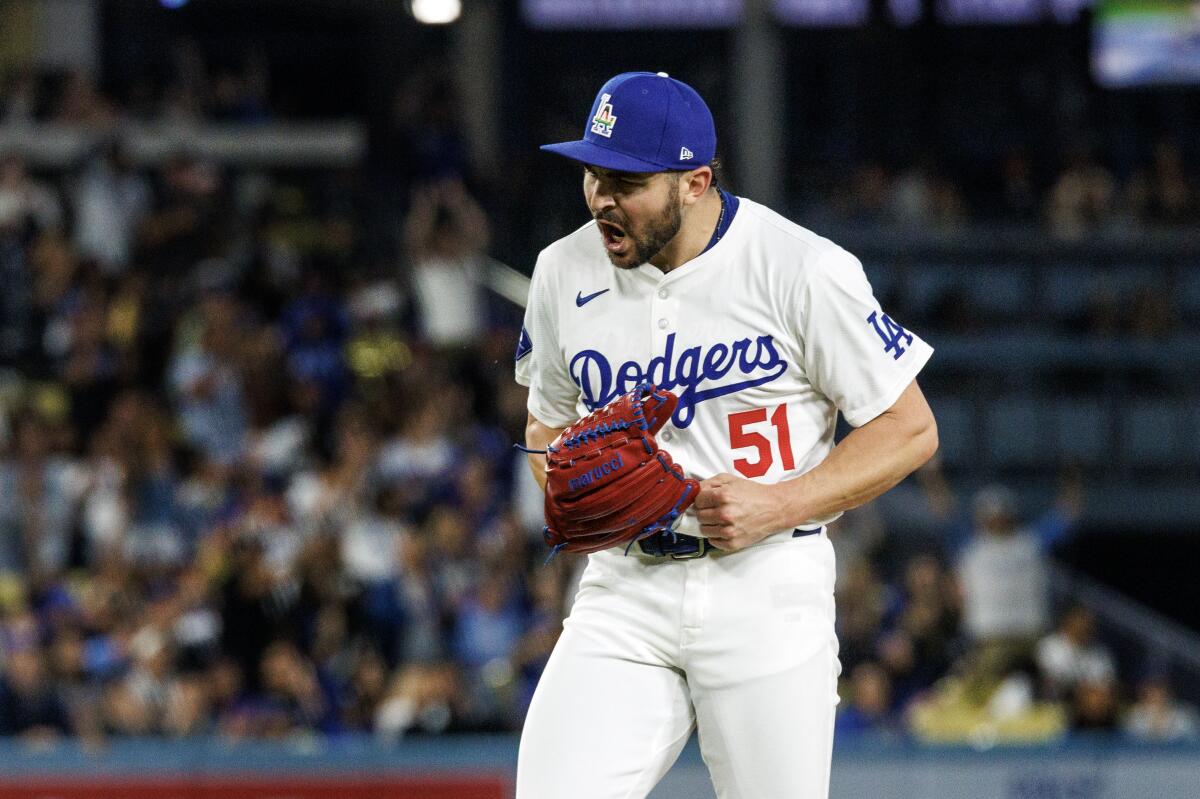
Dodgers relief pitcher Alex Vesia reacts after earning a save to close out a 4-3 win over the Royals on Friday.
(Gina Ferazzi/Los Angeles Times)
Kiké Hernández grounded back to the mound for the second out, but Taylor jumped on a 2-1 changeup, lining his homer into the left-center field pavilion to make it 3-3. It was only Taylor’s 10th hit and second extra-base hit of the season.
“I try to just take it day by day, but I definitely have my moments of frustration,” Taylor said of his season-long struggles. “It’s kind of weird, not being in there that often. Some days you’re feeling good and you don’t play. Then sometimes you’re not feeling good. I’m just trying to be consistent with my work and ready when the opportunity comes.”
Roberts, a former big-league outfielder, said he couldn’t imagine going through what Taylor has endured this season.
“For me, there would’ve been a lot of sleepless nights,” he said. “But he comes in every day ready to help us win, and that’s just sort of who he is. … He’s pretty much the same whether he’s going really well or scuffling.”
Taylor’s wife and young son, Theo, who was born last year, help keep things in perspective.
1
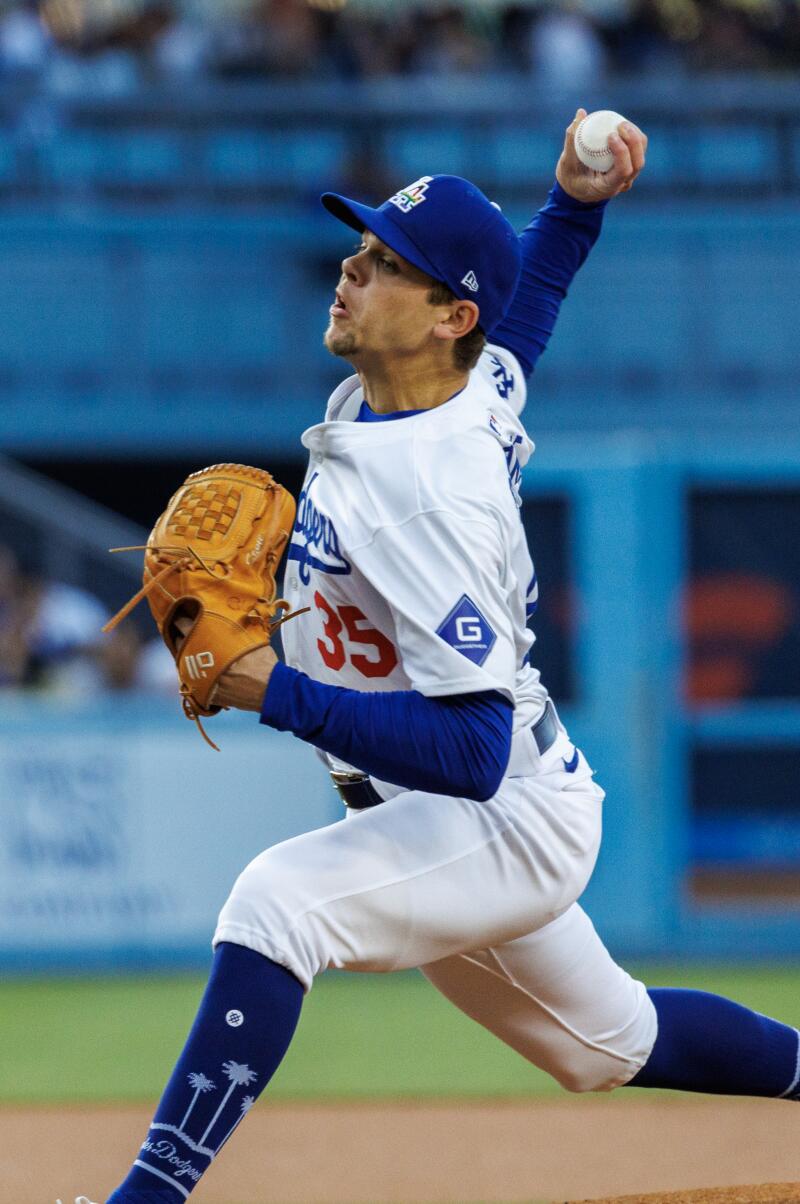
2
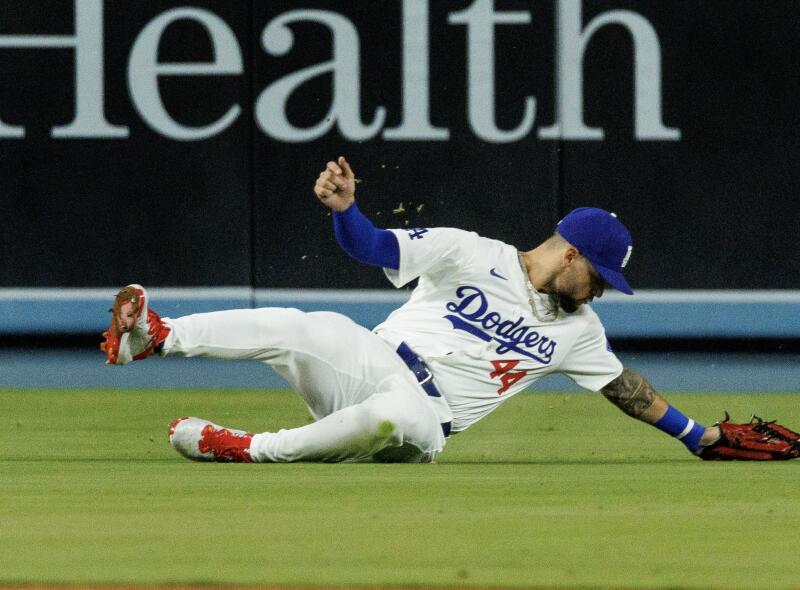
3
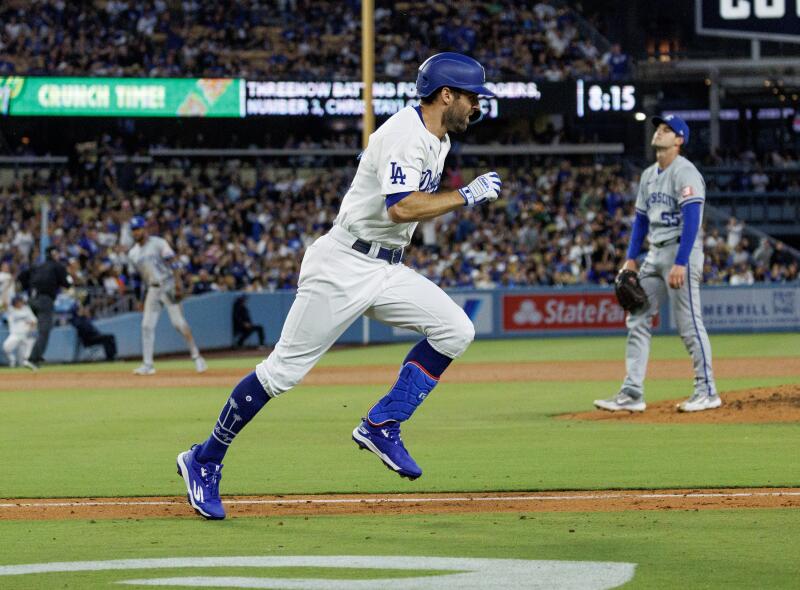
1. Dodgers starting pitcher Gavin Stone delivers against the Royals in the first inning Friday. 2. Dodgers center fielder Andy Pages makes a sliding catch in the seventh inning. (Gina Ferazzi / Los Angeles Times) 3. Chris Taylor runs the bases after hitting a solo home run off Royals pitcher Cole Ragans in the fifth inning.
“I don’t know how I would have handled this earlier in my career,” Taylor said. “I think I took things home with me a lot more. Now that I have my wife and kid at home, it’s a good escape from all of this. I’m very thankful that I have them.”
Stone, who entered with a 7-2 record and 2.93 ERA in 12 starts, blanked the Royals on one hit through three innings but ran into trouble in the fourth, Maikel Garcia leading off with a single to center, taking second on a Bobby Witt Jr. groundout and third on a wild pitch. Vinnie Pasquantino walked to put runners on first and third with one out.
Stone then hung an 88-mph first-pitch slider to Perez, who demolished the middle-of-the-plate offering for his 11th homer of the season, the ball leaving the veteran catcher’s bat at 113.3 mph and traveling 437 feet for a 3-0 lead.
“Yeah, no doubt, for sure,” Stone said, when asked if he wanted that pitch to Perez back. “But once it’s over, you can’t really do anything about it. You can only focus on the next hitter, and so just having that approach helps a lot.”
Stone escaped a first-and-third, two-out jam in the fifth by getting the dangerous Witt to fly out to center field, and he retired the side in order in the sixth and seventh innings to give the Dodgers a chance.
1
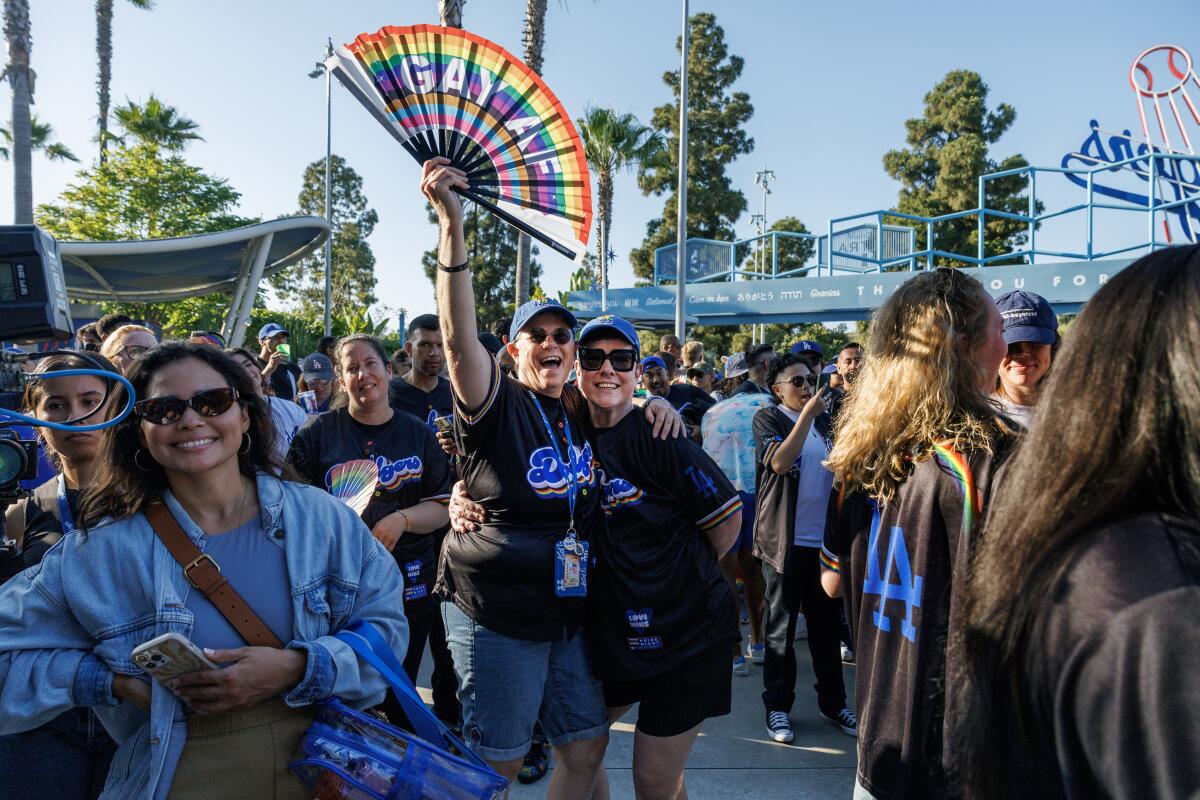
2
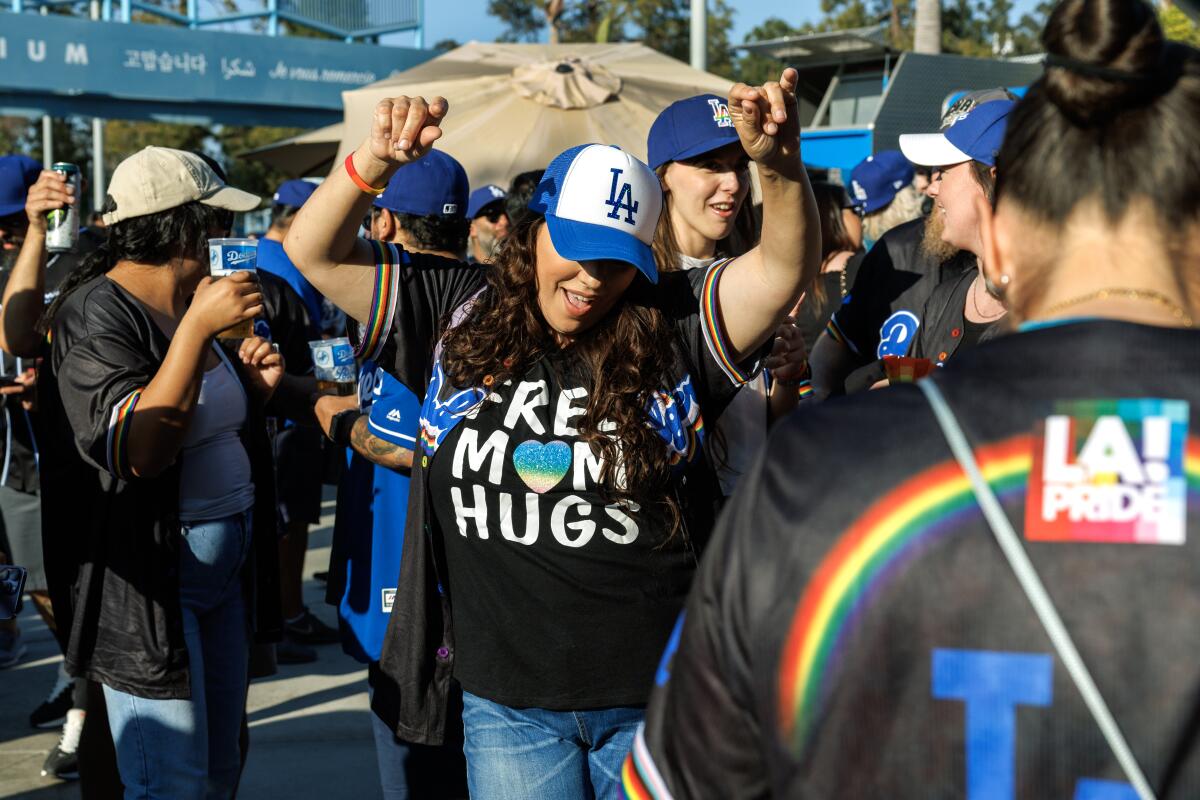
3
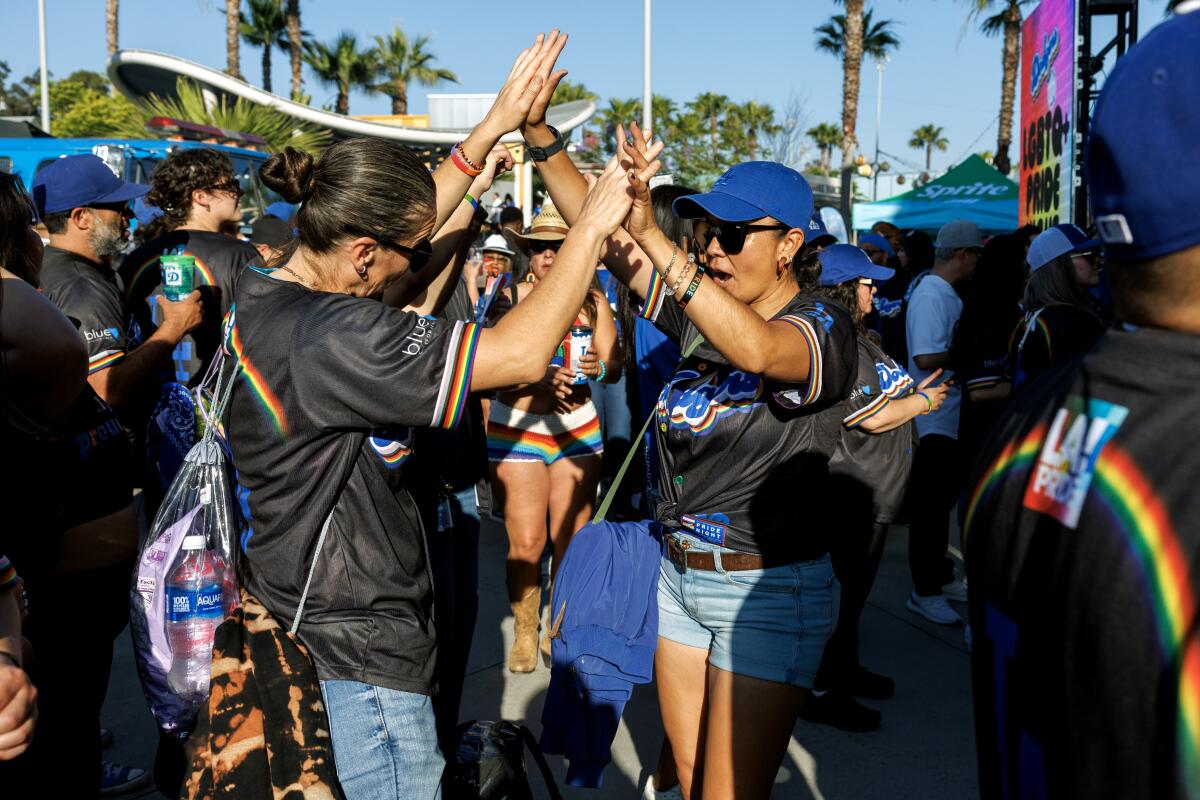
4
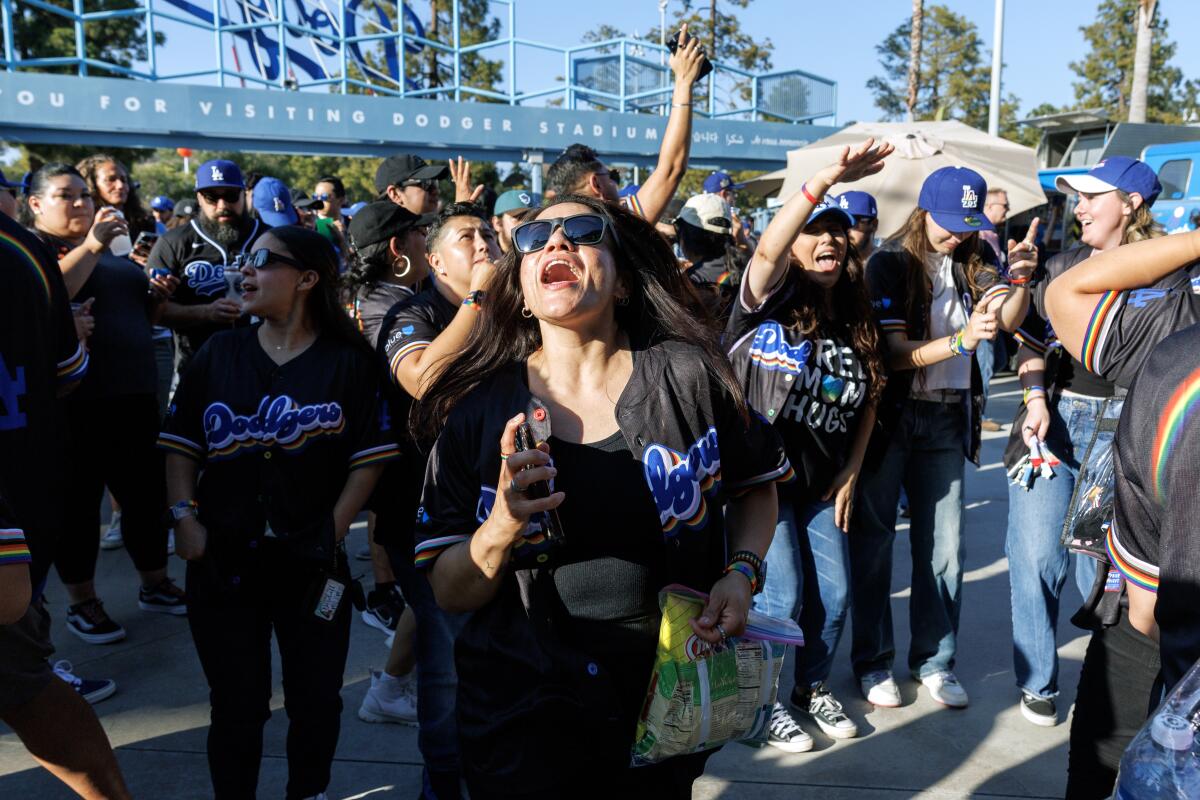
1. Dodgers fans Denise, left, and Colleen Quinn-Allen enjoy Pride Night at Dodger Stadium before Friday’s game against the Kansas City Royals. 2. Dodgers fans dance to music during Pride Night at Dodger Stadium. 3. Dodgers fans enjoy Pride Night at Dodger Stadium. 4. Dodgers fans enjoy Pride Night. (Gina Ferazzi / Los Angeles Times)
It marked the fourth time in nine starts that Stone, who gave up three runs and four hits, struck out three and walked two for a no-decision, completed seven innings.
“I’ve got all the trust in the world in him that he can make a pitch when he needs to, get back after a tough inning and keep us in the ballgame, which he did,” Roberts said of Stone. “He saved the bullpen, which was a bit in limbo. It seems like he does that every time he takes the baseball, and he’s earned that trust.”

Sports
Rory McIlroy and the U.S. Open he will never escape — even though he tried

PINEHURST, N.C. — Within seven minutes of Bryson DeChambeau’s ball landing in the cup, the ripping sound of tires skirting on pavement whipped through Pinehurst Resort as Rory McIlroy’s courtesy Lexus SUV pulled out of his 2011 U.S. Open champion parking place and drove away from the day he’ll never escape. He stared into the distance as his agents and caddie spoke around him. No interviews. The 35-year-old Northern Irishman simply tossed his clubs and workout bag into the trunk, slipped into the driver’s seat and threw it into reverse. The U.S. Open ended at 6:38 p.m. At 7:29 p.m., McIlroy’s Gulfstream 5 took off, leaving the Sandhills of North Carolina without his fifth major championship but with the collapse that will define him forever.
Just 90 minutes earlier, McIlroy strutted down the 14th fairway prepared to redefine his career. Ten years without a major. Ten years of pain and close calls, a man who won four majors by the time he was 25 then fell short again and again. And here he was, with five holes remaining at the U.S. Open, leading Bryson DeChambeau and the field by two strokes.
But Rory McIlroy did not win the 2024 U.S. Open.
Three bogeys and a pair of missed three-foot putts later, McIlroy lost it to DeChambeau. It will be remembered far more than any of his four wins.
Chewing a nutrition bar walking off the 14th tee, McIlroy leaned over to peek at the 13th green to his right. McIlroy had a two-shot lead because he had just birdied 13 as DeChambeau — playing in the final group as the 54-hole leader — had bogeyed No. 12. But DeChambeau put his drive safely on the par-4 13th with a putt for eagle, and McIlroy wanted to get a look. DeChambeau ultimately birdied to get back within one.
McIlroy entered Sunday at Pinehurst three shots back of DeChambeau. He was not supposed to win this, but he seemingly went and grabbed it. For 13 holes, we saw the version of McIlroy many pleaded for during the past decade. He looked like a killer, or some version of it. He opened with a birdie on the first hole and birdied Nos. 9, 10, 12 and 13 with lengthy putts. He was winning this major.
But golf is not a sport kind to the premature formation of narratives.
😱 😱 😱 😱
RORY MISSES ON 18.
Bryson can win the U.S. Open with a par on 18. pic.twitter.com/lSk0ZzzZK2
— U.S. Open (@usopengolf) June 16, 2024
He parred No. 14. Then, he bogeyed the par-3 15th after overshooting the green, but that was acceptable. It was one of the hardest holes of the day, and DeChambeau bogeyed it too.
It was on 16 that the fear kicked in. McIlroy had a simple-seeming par putt from two feet, six inches. And he missed. It wasn’t really close, rounding the left edge. Yet McIlroy remained on a mission to stay calm. The instant it missed, he flattened both his palms to give the “calm down” signal. Yet throughout the Pinehurst No. 2 a familiar sentiment was whispered. Not again.
And no matter how hard he tried to steel himself, McIlroy sent his tee shot on the par-3 17th into the left-side bunker. Credit to him, he hit a beautiful, soft pitch out from the sand and saved par.
But what happened next signaled it might be over far before it truly was.
McIlroy put his putter back into his bag, leaned over to grab his driver and his eyes bulged into a fearful grimace. The game plan was out the window. The thoughts that got him here were gone. He was flying blind.
See, McIlroy had a plan this week. He talked about it nearly every day from Tuesday through Saturday. Boring golf. Disciplined golf. Bogeys will happen, so never get flustered. “Just trying to be super stoic,” McIlroy said Tuesday. “Just trying to be as even-keeled as I possibly can be.” And he was for 71 holes, through it all. His tournament could be defined by how impressive that demeanor was, making the kind of ugly, tough par saves he historically missed.
GO DEEPER
U.S. Open analysis: 10 things to know on Bryson DeChambeau’s win
But somewhere between 16 and 18, McIlroy stared into the headlights and wasn’t prepared to look away. He was now a different golfer. His eyes looked like they were playing through each heartbreaking scenario, in turn putting them into fruition. Maybe then, we should have known.
So, for some inexplicable reason, McIlroy pulled out driver. Why, oh why, did he want his driver? The day before, he hit a 3 wood and left himself only a 133-yard wedge shot in. There was no need for extra length on the 449-yard hole. Maybe McIlroy, likely the best driver of the golf ball in recent memory, thought this would be his signature moment. Maybe he was chasing even though he was tied. Either way, McIlroy launched a drive too far left — into Pinehurst’s infamous native area, just in front of a patch of wiregrass. He had no play. He punched out an awkward little roller up to the front of the green. And again, his short game came to play with a nice little chip to three feet, nine inches from the 18th pin.
He missed. Again.
It was as if Bill Buckner let a second ball go through his legs. There is no explanation nor any defense. McIlroy’s short, softly hit putt broke right immediately and rode the right edge of the hole. Rory McIlroy had just bogeyed three of the final four holes to hand away the 2024 U.S. Open, giving Bryson DeChambeau room to earn it with an incredible up and down out of the 18th bunker to par and take the title. If McIlroy made both three-foot putts, he wins the U.S. Open. If he makes one, he goes to a playoff. But he made neither.
McIlroy signed his scorecard in the scoring tent and watched the finish on TV with the slightest, faintest sense of hope. He ate another nutrition bar during DeChambeau’s bunker shot. His hat sat loosely crooked on top of his head for the final putt with hands on his hips. He took one last nervous, sick-to-his-stomach gulp down his throat before the putt fell in. When it did, he turned, looked down, swallowed once more and exited out the door behind him. He gathered his belongings and made his way to the Lexus.
The golfer known for his ability to speak eloquently on all subjects declined to speak to media. There was nothing left to say.
McIlroy’s career began with a collapse. He was just 23 and entered Sunday at the 2011 Masters with a four-shot lead but shot a disastrous 80 to fade away. People will always remember that day, but he won the U.S. Open two months later. It was the first of four majors in as many years. He seemed on pace to chase the greats.
He’s never won a major again.

Rory McIlroy had a two-shot lead with five holes to play Sunday. (Jared C. Tilton / Getty Images)
But unlike so many other sports figures who burned bright early only to fade out, McIlroy’s game didn’t dissipate. He’s remained one of the three or four best players in the world for most of these last 10 years. He’s won 26 PGA Tour events. He’s finished top 10 at 21 of the 37 majors since. By most metrics, the past three years have been his best. He just couldn’t win. Most wouldn’t have even called him a choker. First, he just got off to a bad starts and finished hot. Then, the last three years, somebody else grabbed it from him. At the 2022 Open Championship, he shot a perfectly fine Sunday 70. He just couldn’t hit the 50-50 birdies, and Cameron Smith did to shoot a 64 and steal it. At the 2023 U.S. Open, he entered one back of Wyndham Clark. They shot the same Sunday score. He didn’t hand these away.
The 2024 U.S. Open at Pinehurst? Rory McIlroy choked.
McIlroy has made some enemies in his time, and two of the people he’s bumped heads with most are Greg Norman and Phil Mickelson, two players as synonymous for their epic collapses as they are for their eight combined majors. Norman is most famous for his six-shot 1996 Masters disaster. Mickelson famously double-bogeyed the 18th hole at the 2006 U.S. Open at Winged Foot to give it to Geoff Ogilvy. Now, McIlroy will live forever with those two men.
There aren’t many comparisons in sports to the path of McIlroy. There aren’t other athletes or team dynasties that won multiple titles immediately, stayed at the top of the sport but became known as chokers at the end of their run. The Patriots won three more titles after the Super Bowl losses to the Giants. The core of the 2004 Yankees was aging, and they won again five years later. Jordan Spieth didn’t give majors away after his third major before the age of 24 — his play declined.
The hardest part with McIlroy is always thinking he might get the next one. He is still that good. He still has a runner-up finish at a major each of the past three years. And there’s this idea that if he keeps putting himself in contention, the cards will eventually fall his way.
But on Sunday, something changed. McIlroy is 35 now, and maybe the muscle memory has faded over the last decade. How to put your entire dreams into something and have it work out. How to prove a narrative wrong or hit the perfect shot with thousands of fans living and dying with every swing.
Rory McIlroy sped off out of the Pinehurst Resort parking lot early Sunday evening not just a man in heartbreak. He drove off as forever the man who missed those two putts.
(Top photo: Jared C. Tilton / Getty Images)
Sports
Kirk Cousins spoke to Aaron Rodgers, used him as 'benchmark' in Achilles rehab process
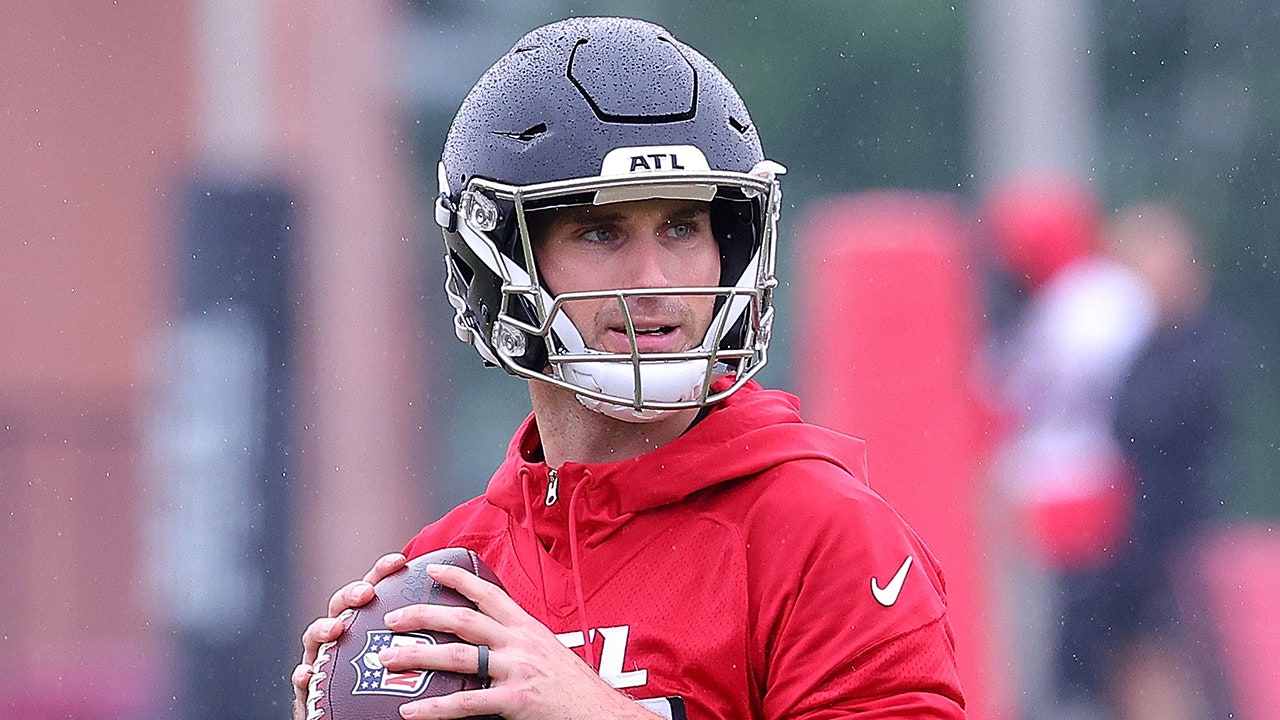
Quarterback Kirk Cousins has taken some hard hits in his NFL career, but he never needed surgery to repair an injury he sustained until Week 8 of the 2023 campaign.
Cousins suffered a torn Achilles, and in a flash, his season was done with surgery imminent to repair the ligament.
“It’s uncharted territory for me,” Cousins told Fox News Digital one day after the offseason workout period came to an end with his new team, the Atlanta Falcons.
Quarterback Kirk Cousins, #18 of the Atlanta Falcons, speaks to the media during OTA offseason workouts at the Atlanta Falcons training facility on May 14, 2024 in Flowery Branch, Georgia. (Kevin C. Cox/Getty Images)
Cousins found a new home in the NFL in free agency a few months back, but the veteran signal caller was not worried about that in late October 2023, when he knew he needed to go under the knife, and take on a rehab process he knew nothing about after the fact.
It is a scary thought for anyone, let alone a 35-year-old quarterback, to think about the daunting recovery process ahead. However, Cousins took things in stride and got some help from others, including New York Jets quarterback Aaron Rodgers.
Rodgers, of course, tore his Achilles four plays into his new tenure with the Jets and was already in his own recovery process when Cousins tore his seven weeks later.
FALCONS LOSE DRAFT PICK, FINED BY NFL FOR TAMPERING DURING KIRK COUSINS PURSUIT
“Aaron’s a couple months ahead of me,” said Cousins, who also discussed how he “recharges the batteries” during his summer on his Manitou Pontoon Boat in Michigan before training camp. “I reached out to him before surgery back in late October, and we had a good conversation.”
With Rodgers specifically, Cousins explained how he would use him as a “benchmark” for his recovery, giving him a “good indicator of where you can be in two months.”
There is also looking at those who recovered from their Achilles.
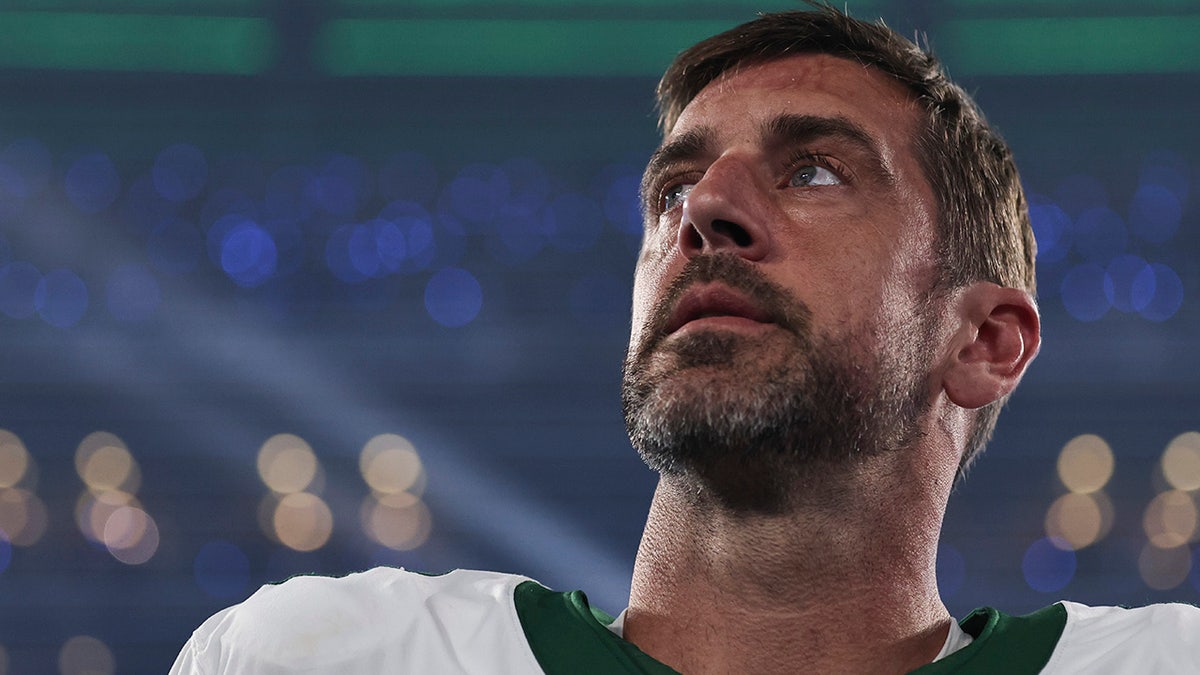
Aaron Rodgers, #8 of the New York Jets, looks on during the national anthem prior to a game against the Buffalo Bills at MetLife Stadium on Sept. 11, 2023 in East Rutherford, New Jersey. (Michael Owens/Getty Images)
“I like talking to people who are four, five, six years removed from an Achilles tear,” he said. “When I looked up people who’d torn one, it’s more common than I’d realized – among the NBA, among former quarterbacks. Athletes in general, and guys who went on to have success post-Achilles tear. So, it was encouraging to see the careers people have had before and after an Achilles tear.”
When Cousins had his recovery process broken down for him, he said it was a nine-month journey before he could really get back on the field and start going through drills. That was supposed to be Aug. 1 of this year.
“They said that you don’t really feel back to yourself until 12 months, but you can be back on the field sooner than that,” Cousins said. “I had hoped to be back sooner than nine months, but wasn’t sure. At OTAs, we had these practices, and when I first got injured, they said, ‘You’ll sit out of those practices, but training camp you’ll be good to go.’”
However, when it came time to join his Falcons teammates for OTAs, Cousins was seen with his red jersey, black helmet and on the field throwing the ball. As he put it, a “positive process.”
“I wasn’t going a million miles an hour, but I was able to get those reps and I felt like that really helped me get to know my teammates, get to know the system, get comfortable,” he said. “That was a step in the right direction. Now, over the summer break, it’s about continuing the rehab, so I can get closer to full speed by training camp and certainly by Week 1.”

Minnesota Vikings quarterback Kirk Cousins, #8, looks on from the sidelines during the second half of an NFL football game between the Minnesota Vikings and the Detroit Lions in Detroit on Sunday, Jan. 7, 2024. (Jorge Lemus/NurPhoto via Getty Images)
For a competitor such as Cousins, it is hard not being able to go full speed, especially in a new situation. However, the one fundamental part about Achilles recovery that he has learned – and still learns about every day – is how there is a tightrope to walk in terms of pushing the body to get back to full strength.
“They told me when I first injured it that you have this line in your rehab that you want to push up against,” he said, picking up his hands and putting them close together. “You’re not going to get back fast if you are back here and not pushing it. But you cannot cross the line, because when you cross the line, you also set yourself back.
“So, it’s been this dance of trying to figure out am I pushing it enough where I’m asking my body to take that next step in the healing process? But am I pushing too hard, also, and trying to go up against that line and not cross it? That really is the definition of good quality rehab, so I’ve been trying to find that since day one.”
The Falcons saw enough back in March when they dished out a four-year deal to Cousins worth $180 million with $100 million guaranteed. However, neither party will truly know how he will be on the gridiron in year 13 coming off his toughest injury yet.
Cousins continues to work toward that moment where he can prove he is still one of the best quarterbacks in the league, one who can lead the Falcons back to the playoffs for the first time since 2017.
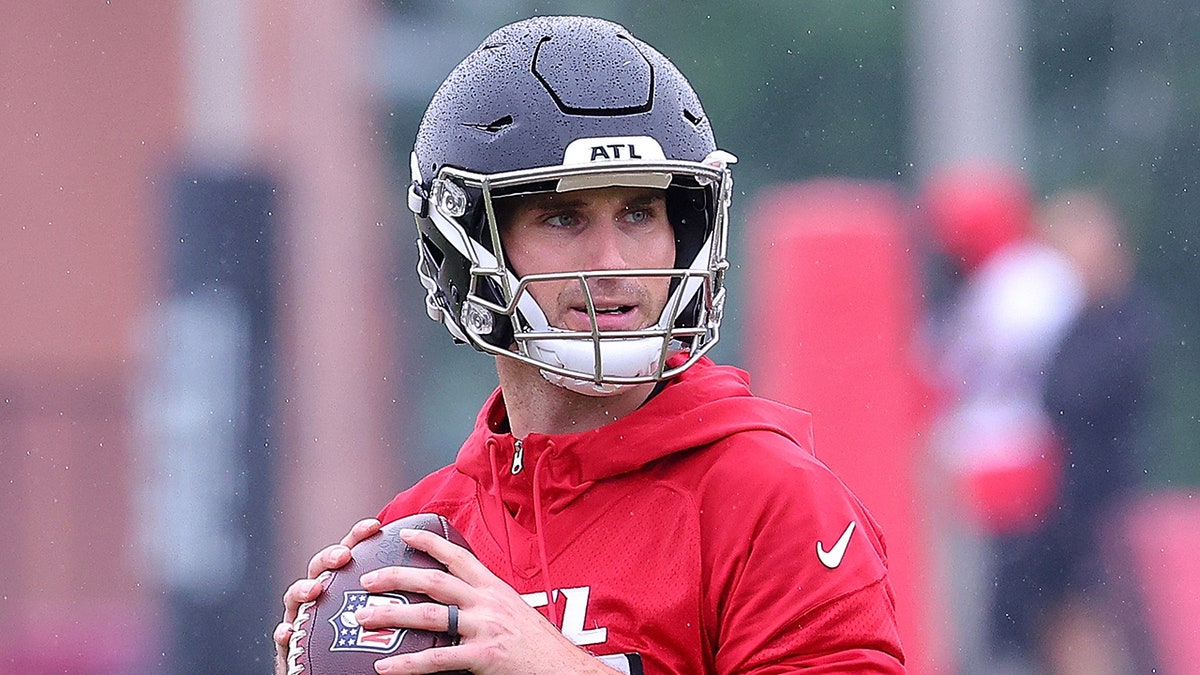
Quarterback Kirk Cousins, #18 of the Atlanta Falcons, looks to pass during OTA offseason workouts at the Atlanta Falcons training facility on May 14, 2024 in Flowery Branch, Georgia. (Kevin C. Cox/Getty Images)
In doing so, perhaps Cousins can be the one others call for advice on how to get to the point of success post-Achilles tear.
“I’m hoping to be able to add my name to that list,” Cousins said with a grin.
Follow Fox News Digital’s sports coverage on X, and subscribe to the Fox News Sports Huddle newsletter.
Sports
Shohei Ohtani and Miguel Rojas help fill in for injured Mookie Betts in Dodgers' win

No Mookie, no problem.
For one night at least.
In the Dodgers’ first game without star shortstop Mookie Betts, who is expected to sit out roughly six to eight weeks because of a fractured hand he sustained Sunday, the team cruised to a 9-5 win over the Colorado Rockies at Coors Field.
And, in a reminder of the talent on the Dodgers’ roster, they received some of their biggest contributions from the two players taking over Betts’ primary responsibilities.
Without Betts at the top of the lineup, designated hitter Shohei Ohtani was bumped up to the leadoff spot and went three for four with an RBI and a walk.
Without Betts at shortstop, Miguel Rojas slid back over to his natural position and christened the return with a three-hit, two-run, one-RBI outburst, continuing an impressively productive start to the season the Dodgers will need to last for the foreseeable future.
The Dodgers received plenty of help from others Monday, including a seven-inning, one-run, two-hit start by James Paxton (one of the pitchers who will have to step up in the absence of Yoshinobu Yamamoto, who also suffered a significant, but non-season-ending injury this weekend), three hits from Jason Heyward and a career-high five walks from Freddie Freeman.
But, in the big picture, it was the play of Ohtani (who was batting leadoff for only the second time this season) and Rojas (starting at shortstop for only the fourth time in the last month and a half) that was most encouraging to a club still reeling from Betts’ injury.
“You just don’t know how things are gonna go after you lose Mookie,” Freeman said. “So we kind of responded today. The game we played today, that was huge for us. So we’ll just hold it down until Mookie can get better.”
Ohtani’s performance served as an encore to Sunday, when he emerged from an 11-for-51 slump with two home runs. The star slugger didn’t leave the yard again Monday, but he did single home a run in the second, before hitting back-to-back doubles in the fourth and sixth innings — the latter on an opposite-field bullet down the left-field line.
“We haven’t seen him drive a ball to left field like he did for that double in quite some time,” manager Dave Roberts said. “So that’s a good sign.”
Ohtani now has a .314 batting average and .989 OPS, ranking fourth and second in the National League, respectively.
For the time being, Ohtani will also serve as the Dodgers’ leadoff hitter, moving up from a No. 2 spot that on Monday belonged to catcher Will Smith, the former cleanup hitter. Freddie Freeman remained in the No. 3 spot, and Teoscar Hernández batted fourth.
Is this the new look Roberts will use at the top of the lineup?
“I think versus the right-hander, I like this,” Roberts said, not entirely tipping his hand. “Against left, I will probably think through it. But this feels right, versus both right now.”
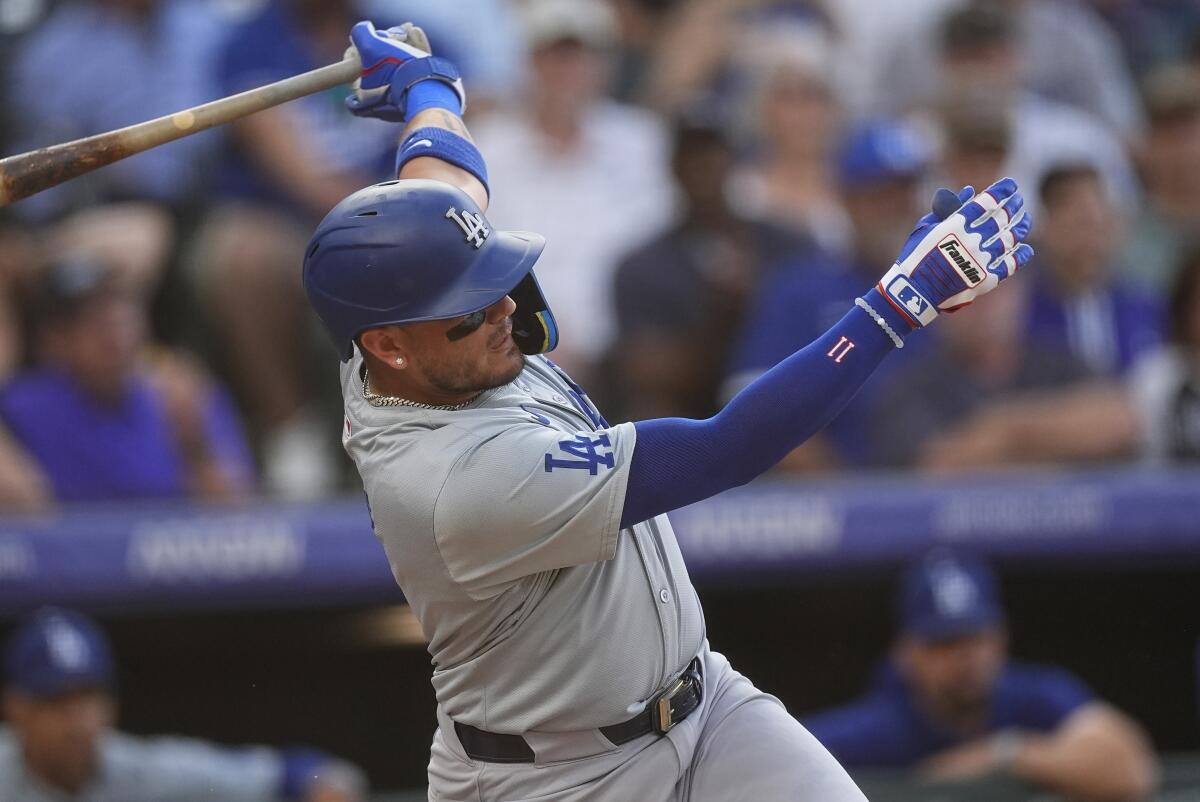
Dodgers shortstop Miguel Rojas singles during the third inning against the Colorado Rockies on Monday.
(David Zalubowski / Associated Press)
Roberts made the Dodgers’ shortstop plans much more clear, stating that, in Betts’ absence, Rojas will start the majority of the games at the position, with Kiké Hernández backing him up in addition to his other roles at third base and the outfield.
Rojas has the glove to be a starting shortstop, the role he served for the Dodgers for most of last year and the Miami Marlins the six seasons before that. He has been a pleasant surprise at the plate, raising his batting average to .292 and OPS to .799 with two singles and an RBI double in the seventh inning Monday.
In games Rojas has recorded at least one hit this season, the Dodgers are 20-0.
The big question with Rojas, 35, has been durability.
Last year, when he unexpectedly started 109 games after Gavin Lux’s spring training knee injury, Rojas was bothered by nagging cramps in his hip. Earlier this month, Roberts said some lingering leg soreness was affecting Rojas, as well, contributing to the reason why, before Monday, Rojas had started only 30 of 73 games this season.
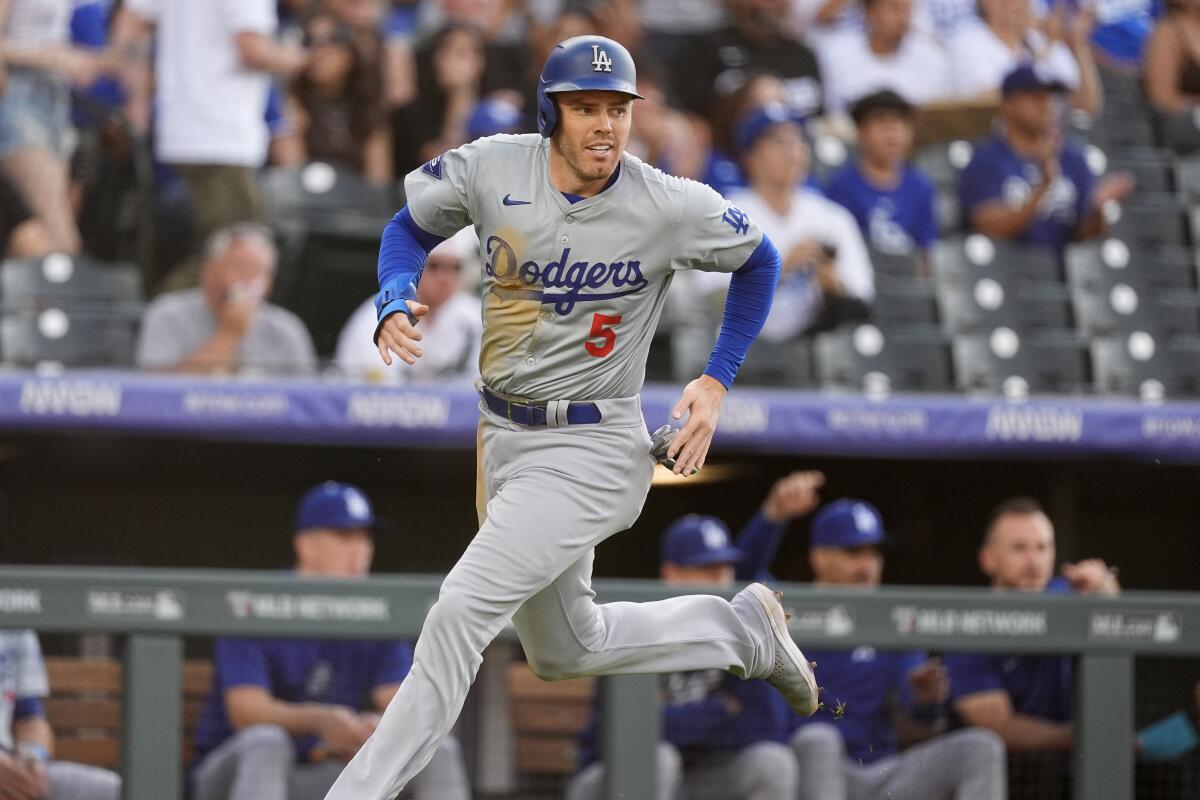
Freddie Freeman rounds third base to score on a double hit by Teoscar Hernández in the first inning. Freeman was walked five times in the game.
(David Zalubowski / Associated Press)
“I’m not 30 years old anymore,” Rojas said. “It takes special preparation, doing rehab, doing postgame work, so that’s what I’m doing.”
On Monday, both Rojas and Roberts expressed confidence in the 11-year veteran handling an increased workload. This week, Rojas will start in three of the four games at Coors Field.
“He would argue he could play every day,” Roberts said. “But my job is to manage it, so I think that’s a good rhythm for him. He’s in a good rhythm right now.”
Rojas’ shortstop defense has also remained sharp, thanks largely to his extensive routine of pregame infield drills alongside Betts this season, in which Rojas has served as a sounding board during Betts’ transition to the position.
Because of all the time they’ve spent together this season, Rojas said he was sad and angry when he saw Betts writhing on the ground in pain Sunday, after being plunked by a 98-mph fastball.
“It affected me a lot,” he said. “I don’t ever want to see Mookie go down like that, because I know his desire and drive to be great.”
In his first chance to step up in Betts’ place, though, Rojas and the rest of the Dodgers’ lineup delivered, helping ensure the Dodgers’ first game without their former MVP winner wasn’t one in which his presence was dearly missed.

-

 Movie Reviews1 week ago
Movie Reviews1 week ago‘Darkest Miriam’ Review: Britt Lower in a Marvel of a Drama About a Young Librarian’s Loves and Fears
-
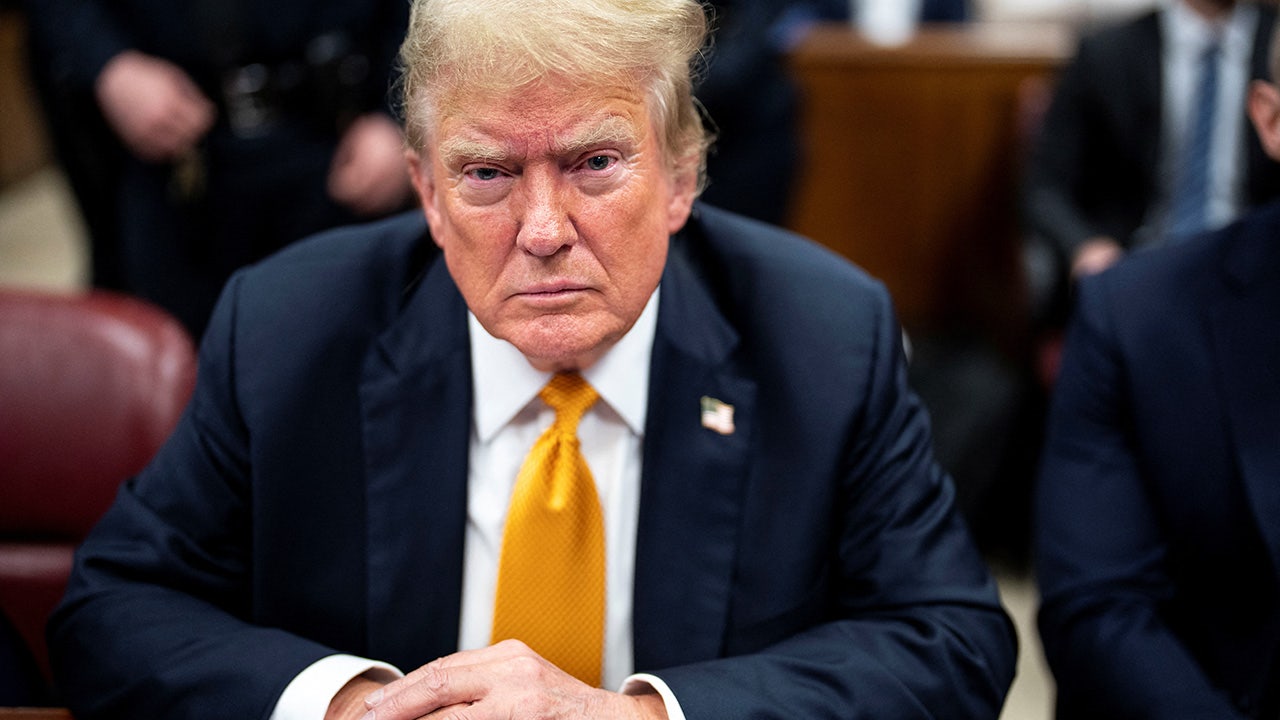
 Politics1 week ago
Politics1 week agoGun group vows to 'defend' Trump's concealed carry license after conviction
-
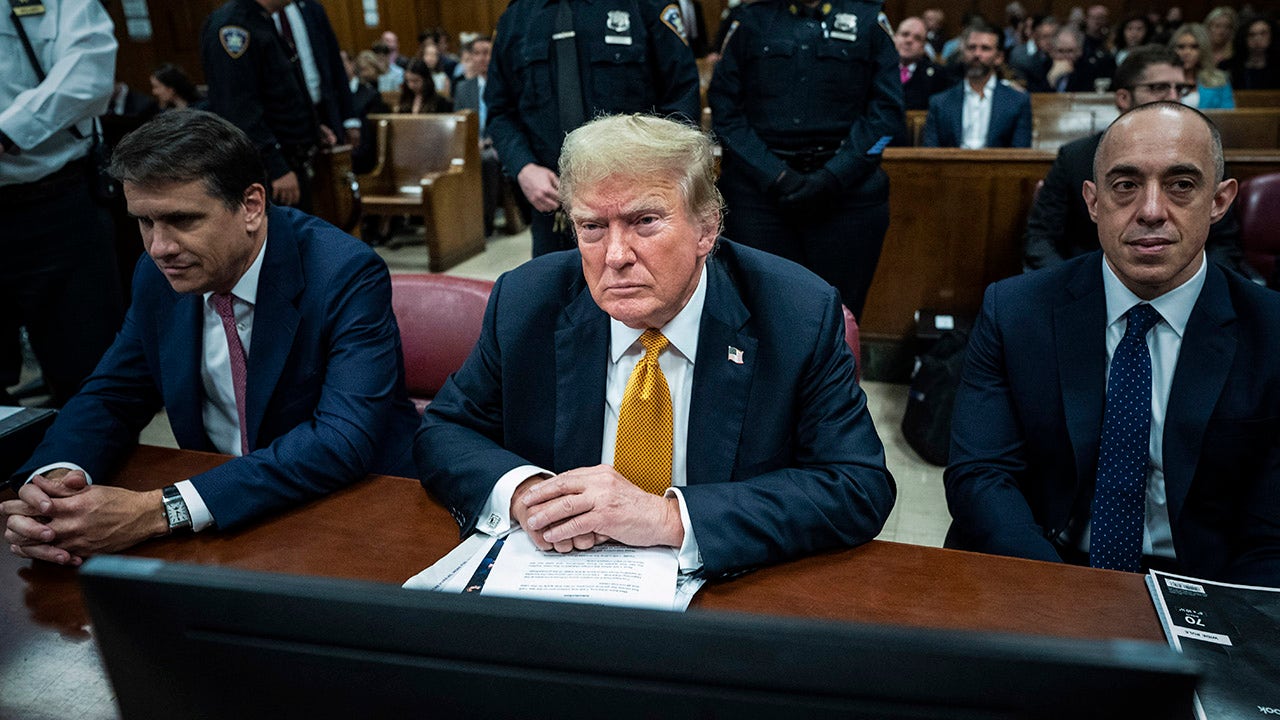
 Politics1 week ago
Politics1 week agoShould Trump have confidence in his lawyers? Legal experts weigh in
-
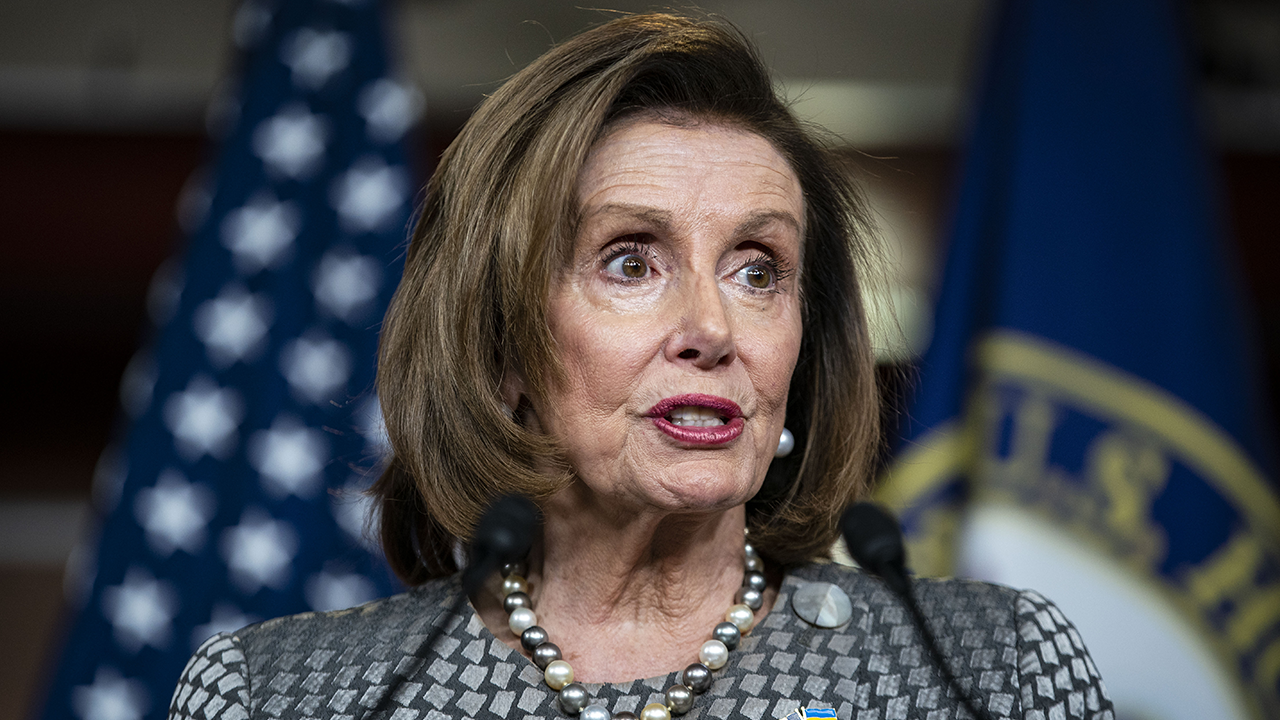
 Politics1 week ago
Politics1 week agoGOP releases Jan. 6 clip of Pelosi saying 'I take responsibility' as she discussed National Guard absence
-
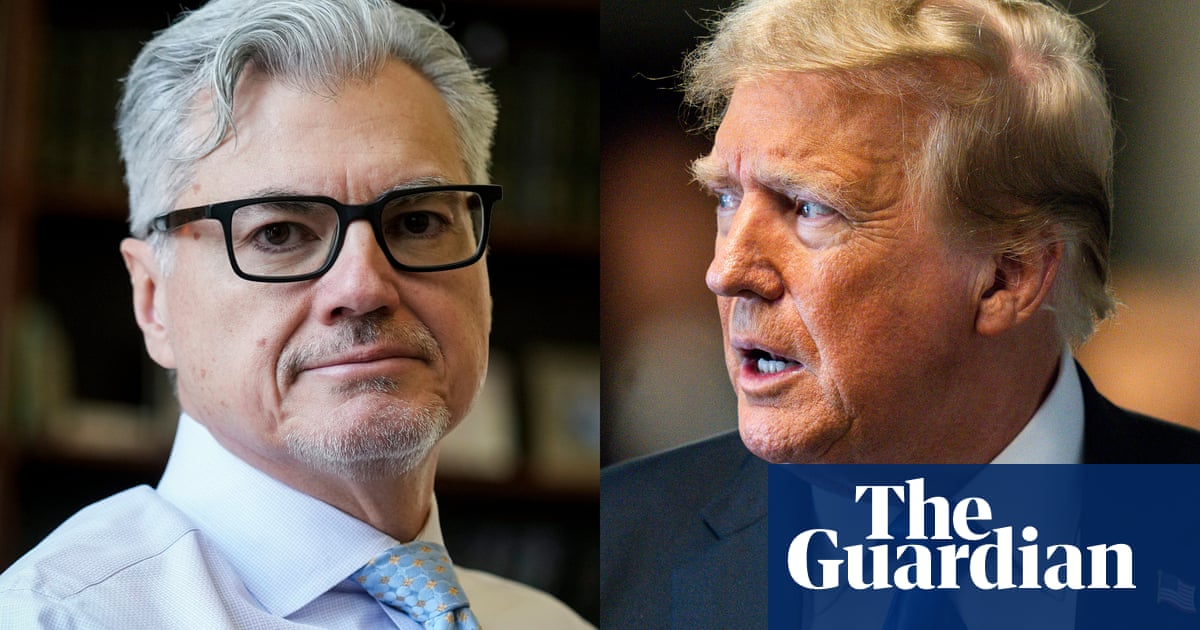
 News1 week ago
News1 week agoTrump to escalate blame on trial judge Juan Merchan if sentenced to prison
-
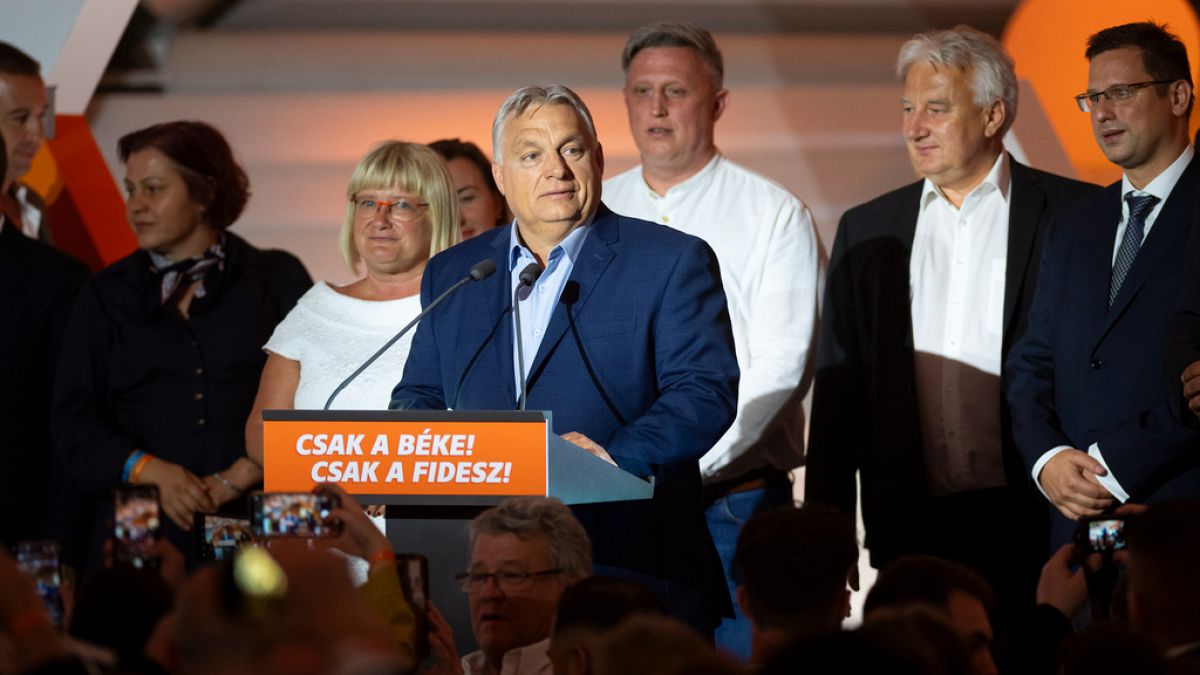
 World1 week ago
World1 week agoOrban party loses major support in Hungary's EU election
-

 World1 week ago
World1 week agoEU elections: Slovakia and Italy voting; Far-right surge expected
-

 World1 week ago
World1 week agoUkraine reconstruction official quits citing ‘systemic obstacles’










